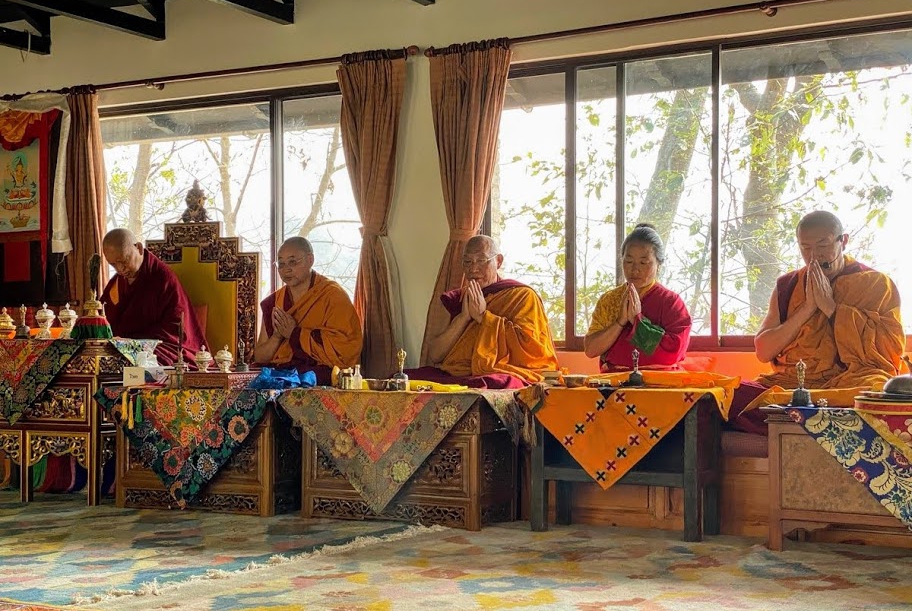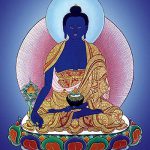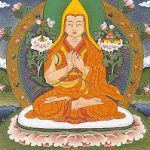
Puja is the name given to the wide variety of devotional and offering ceremonies practiced in all Buddhist traditions. The word itself comes from the root of the ancient Tamil cultura meaning ‘to do with flowers’ while pujas themselves probably developed from the custom of offering the Buddha flowers on his arrival in a particular place during his travels. Pujas consist of placing flowers, lights, food and incense in front of a symbol or image of the Buddha.
Pujas are an integral part of Tibetan Buddhism, and are strongly recommended by Lama Zopa Rinpoche, the spiritual guide of the FPMT, to which Buddha House is affiliated.
The Sanskrit word puja simply “reverence, honour, homage, adoration, or worship”, so a Puja is a ceremony that enables us to create the highest merit by making actual and visualized offerings, with the bodhicitta motivation, to the highest objects of offering, the Guru and the Triple Gem – the Buddha, Dharma and Sangha. That merit is the basis for achieving every good thing up to and including enlightenment.
Everyone is welcome to attend any puja. Here’s what to expect when you come:
Most pujas are done in English, with the exception of Guru Puja (Tibetan: Lama Chopa Puja), which has some verses chanted in Tibetan. Our prayer books display both the English and Tibetan, so it’s easy to follow the meaning. You can always just read along to get a feel for what it’s about, no need to participate in other parts of the ritual.
Seating for the puja is set up differently than for a teaching, with rows of seats facing each other. Anyone is welcome to sit in these seats, either on cushions or in chairs. Whilst generally men sit one side, women on the other, this is not obligatory – sit wherever you feel comfortable.
A puja is a ritual that helps us combine understanding and meditation with devotion that enriches and enhances all aspects of our practice and ourselves. It involves using our body, speech and mind. Kyabje Thubten Zopa Rinpoche emphasizes that by coming together to perform a devotional ceremony we create an energy that is greater than the sum of the individuals participating, and this in turn becomes an offering/puja to all kind, suffering mother sentient beings.
Lama Yeshe likened a puja to a straw broom. “You can’t sweep much floor with just one straw, but when many straws are gathered together to make a broom, you can clean an entire assembly hall in no time at all.”
Three of the pujas that we celebrate regularly at Buddha House are the Medicine Buddha Puja, the 16 Arhats Puja and the Guru Puja (Tibetan: Lama Chopa Puja).

Medicine Buddha Puja
Medicine Buddha practice is important and helpful is so many ways. People associate it just with sickness and healing the body, but it is also very powerful for purifying and healing the mind. It helps purify broken vows. It is very powerful for purifying negative karma and for success in any activity we wish to engage in, including business, helping in court cases, preventing violence. And of course the most important success is to have the realizations of the graduated path to enlightenment. And this practice is extremely beneficial for the dead and dying. All this is due to the Medicine Buddha’s great compassion and the power of the great prayers he made as a bodhisattva to benefit sentient beings.
Medicine Buddha Pujas are performed for the sick, for the dying and for the deceased. The knowledge that there is indeed something we can do for those who are sick and dying can be especially comforting during a time when we may feel helpless.
So if you want to help yourself, your family, your friends, those who are sick or dying, and sentient beings in general, come along to the Medicine Buddha Puja. Bring some offerings of flowers, fruit, biscuits and candles to increase the merit. Medicine Buddha Pujas are conducted in English.

Guru Puja (Tibetan: Lama Chöpa Puja)
This is an offering to the Guru that is performed twice a month, on the 10th and 25th of the lunar calendar. Although it is a practice of highest yoga tantra, Kyabje Zopa Rinpoche encourages all students to attend if they have faith in tantra. You may think that this is too advanced or not necessary because of not having made connection with a teacher yet. But as the ceremony is about the importance of the guru, seeing the guru’s qualities and kindness, it is a powerful way to create the cause to meet the perfect teacher. It involves making offerings and requests to have all the attainments of the path to enlightenment. The whole path is outlined in the form of a requesting prayer. Kyabje Zopa Rinpoche says that this practice helps purify all the obstacles to these attainments, especially the heavy negative karmas created in relationship to the guru in this and past lives. Rinpoche says: “If you are able to do Lama Chopa well, you can achieve enlightenment in this very brief lifetime”. Lam Chopa Pujas are in English with some verses in Tibetan.
So considering the benefits to yourself and others, why wouldn’t you come?

Sixteen Arhats Puja
Buddha Shakyamuni personally selected the Sixteen Arhats from amongst his disciples and requested them to protect the Dharma. At the time of the parinirvana they vowed to remain in the world and maintain the Dharma until the time of the future Buddha Maitreya.
This puja, The Wish-fulfilling Gem Enhancing the Buddha’s Doctrine, a Method for Making Offerings and Prayers to Guru Shakyamuni Buddha and the Sixteen Arhats by Yeshe Gyaltsen, includes a purification practice and is suitable to be performed by anyone.
“It has greater blessings to pray to the kind compassionate Guru Shakyamuni Buddha, the Founder, who is caring with a loving mind for us migratory beings who are in the end of the five-hundred age time. He left the Sixteen Arhats as a regent of himself not to pass away and to be the Savior for us sentient beings.
The benefits of making offerings and prayers to the Sixteen Arhats are:
1. All the Victorious Ones (Buddhas) are pleased.
2. Anyone who correctly practices it will have no obstacles.
3. One will be able to abide in pure morality.
4. It increases one’s scriptural understanding and realization.
5. One will have perfect inner and outer conditions to practice Dharma.
6. One will not be overwhelmed by untimely death and will have a long life.
7. The community of Sangha will be increased.
8. The study and practice of the Tripitaka (Three Baskets) will increase.
And so forth, there are infinite benefits one will enjoy until enlightenment is achieved.”
Translated by Lama Zopa Rinpoche at Caloundra, Australia, on August 10, 1996.
Sponsor a Puja
Sponsoring a puja is a great way to earn merit – your sponsorship serves our entire community by helping to make pujas possible. In addition, as a sponsor, you can offer a dedication that will be read at the puja, so that all who attend can share in supporting your concern.
If you would like to sponsor a puja, full details are here.
Prayers and Mantras
Whilst Venerable Thubten Dondrub (Resident Teacher at Buddha House) was at Hayagriva Buddhist Centre in Perth, he recorded many Prayers and Mantras in English and Tibetan. Please visit this page to listen to them.
